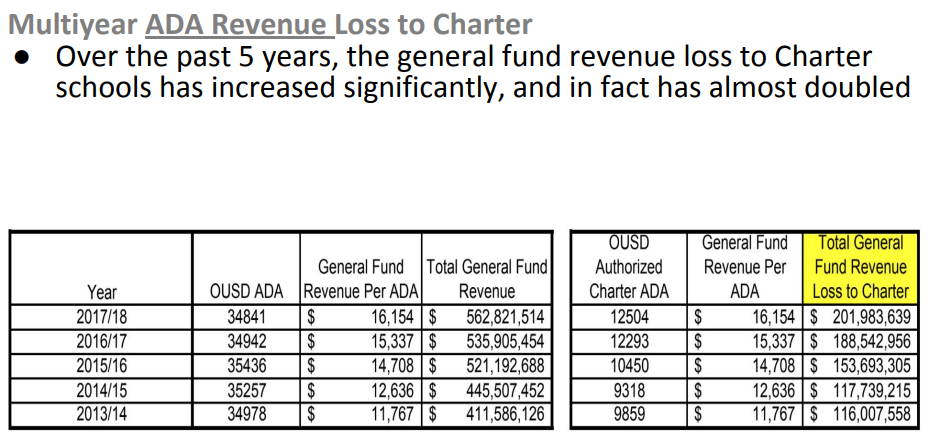If anyone needed an argument for a state takeover of OUSD, they inadvertently got one from Director Eng’s recent presentation to the State Charter Task Force in which she seemed to completely misunderstand school finance. If you wonder why the Board and district have been mired in mismanagement, chasing their tails and continually failing to address root issues. If you ever wondered about the horrendous performance of many of our schools and the overall failure to serve Black and Brown children in either public school sector—her presentation should show us exactly what is wrong with OUSD and why it won’t be fixed by the current board in its current mode of operation.
You can see her whole presentation here. But let’s look at a couple of slides that should tell much of the story of OUSD and its relationship to charters. And let’s add a couple of data points that might tell a more complete story, including the over $175 million that charters brought into the district in 2017 and the education benefits, that we (sometimes) see for families.
These are complex issues, that we should look at, analyze coldly, and adjust policy as warranted. Misinformation, like that of Director Eng, bring us no closer to answers, and likely move us in the wrong direction.
The Impact of Charters
Charter schools DO have financial impacts of host districts, positive and negative, and we need to have an honest and fact based discussion if we are going to get anywhere. There are areas where charters maybe don’t pay their “fair share” and others where they may not get it. How that balances out is still an open question, and we are no closer to an answer after the OUSD presentation and its misinformation. A presentation that showed a deep ignorance on school finance and a one sided approach that may draw applause and flare tempers of partisans but won’t shed light or solve problems for families.
So lets start with some facts.
District enrollment has been basically flat over the last 5 years
In 2013-14 OUSD had 37,040 students, this year it is 36,286. Meanwhile OUSD is getting more state funding than ever, with the increases in funding over those years far surpassing the percentage of students lost. Still, the district is running 20 million dollar plus structural deficits. This shows clearly that OUSD’s financial issues are not from declining enrollment/charters—at least not primarily. Though they make a convenient scapegoat and do have an impact.
This is not even mentioning the roughly 13,000 school aged kids in Oakland that attend neither a charter or district school. If OUSD could attract one tenth of those children they would have gained students over the last 5 years.
But, yeah its all the charters’ fault.
Accurately Looking at Financial Impacts Requires Honest Accounting
Either Director Eng doesn’t understand anything about school finance or she knowingly presented misleading and inaccurate data—not sure which is worse here. Let’s look at the slide and what is wrong with it. But first a quick primer on school finance.
The state pays public schools a per pupil amount when students attend. Those schools then use that money to hire staff and pay expenses. Some districts do that efficiently and get more in the per pupil than they spend, they have surpluses and reserves. Other districts, like Oakland, tend to spend more per child than they get in—they have a deficit. So, if you are a persistently mismanaged district like OUSD, having more students may actually mean a higher deficit and not solvency.
Normally, when districts or schools have more students, they will need to hire more staff and have additional expenses. Director Eng’s analysis—that she presented to the state—overlooks all of this. Her analysis says—let’s assume every charter closes, all the students come back to the district, and the district doesn’t hire new staff, feed, or transport these students—it has no new costs even though there are 15,000 new students. Yay, now we have hundreds of millions of extra dollars.
That makes no sense. And that type of bad math is why the district is constantly teetering on fiscal crisis. The community and the state deserve better.
So here’s Director Eng’s chart

All the revenue shows, no expenses, not a single kid that might go private or out of district. Not another teacher hired, no more meals fed, no new books. It’s all gravy.
This is the type of accounting that has us in takeover mode. Either trustees need better training, so trustees understand finance, or better honesty, where they don’t present numbers that no rational person would accept.
What is Missing
While charters do impose financial costs, they also bring financial and education benefits (sometimes). Let’s look at some of those.
As reported in the Oakland Post, charters generated $175 million in facility funding for OUSD owned buildings in 2017, they also pay in millions for an oversight fee, facilities, the state debt, pensions, and several other funds. So, we need an honest accounting on both sides of the ledger.
You can see a more serious look at the impact of charter schools on district finances here, from PACE (Policy Analysis for California Education), which estimates about a 1.4% decline in operations costs from charter students for districts. Much lower than the impact of pensions or health care cost increases. But Director Eng didn’t seem interested in the academic research here, just parroting a line fed her.
We are also missing the educational benefit. Let’s be clear there is a reason Oakland has so many charters. The City has the highest percentage of very low performing schools in the entire state. And parents, mostly in the Flats need better choices. They may not always get them in charters but if anyone is curious, I got a host of families you can talk to who don’t give a whit about a district school or a charter they just want a good school where they are respected. And they are struggling to find that in either sector.
Nowhere in President Eng’s presentation did we hear about school quality, what parents want or need, or the abysmal state of quality in Oakland. Neither sector can claim academic victory—at the elementary level both the district and charters are failing to get Black kids to proficiency, at 14% and 15% respectively. But at high schools we see large differences in A-G completion, check out the table below. You have several charters in the 90% range and several district schools around that 30% A-G completion rates. There may be more to these numbers but if I have a Black 8th grader, I have some tough choices to make.

This is why there are so many charters in Oakland. And these are the benefits these parents are reaping. We do need to dig deeper on these numbers. Are they really the same kids? But so long as we are engaged in misinformation wars, I don’t think we will get to that.
I can’t remember the last time I heard Director Eng actually address quality when it comes to Black and Brown students, and how the schools are actually doing.
Why This Matters
Oakland has two public school sectors and neither is going anywhere. We can waste resources fighting, fueled by false information, and leading to false solutions. Or we can start to have a fact-based civil discussion about real costs and benefits and how to best serve students here—something neither sector is doing particularly well, for our most underserved families.
I would expect more from our school board and school board president, but maybe I shouldn’t after watching this mess for decades. Regardless, our families need more, and I hope the board and director Eng can step up and deliver, otherwise someone else will.

